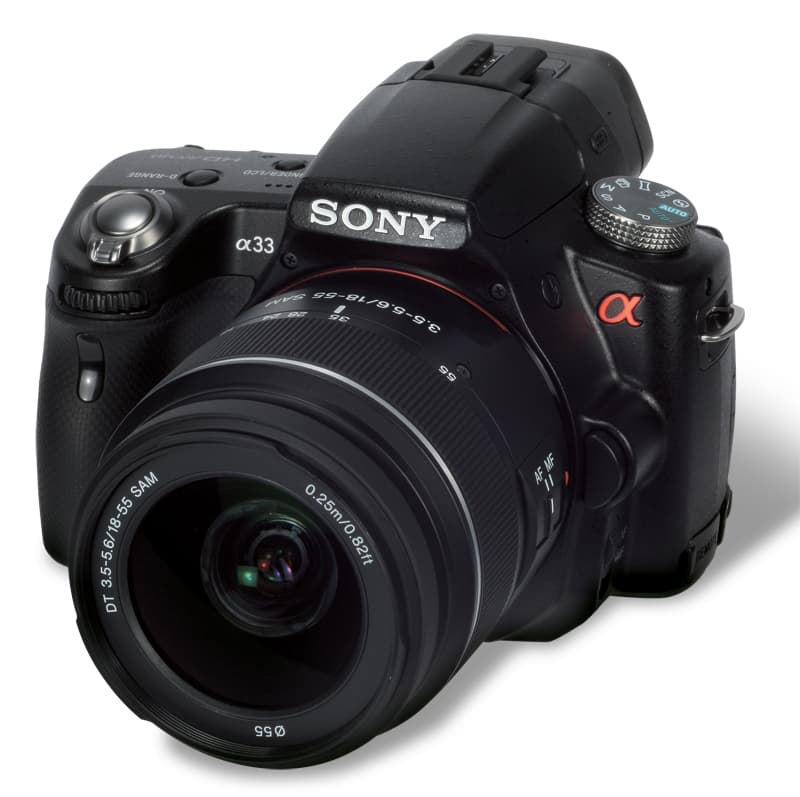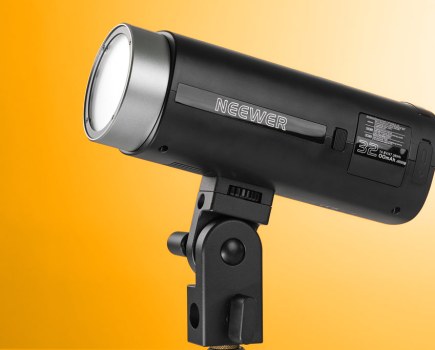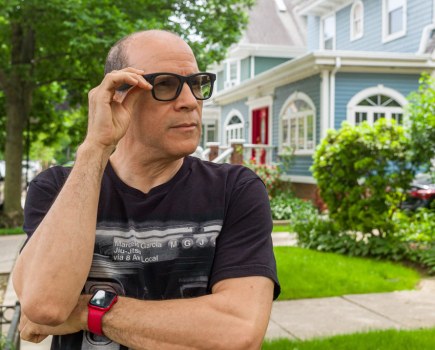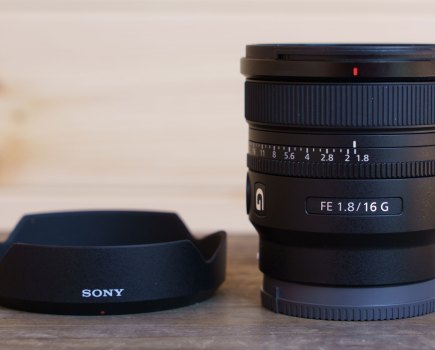Sony Alpha 33 at a glance:
- 14.2 million effective pixels
- 7fps continuous shooting
- New 15-point AF system
- New 1,200-zone evaluative metering system
- Street price: £569.99 for body only
It seems at odds with an apparently ‘forward-thinking’ camera industry that Sony should look to an idea from the past to solve a problem in the present. Yet that is exactly what the company has done with its new Alpha 33 and Alpha 55 SLT (single-lens translucent) cameras.
The problem centres on how to the improve the phase-detection autofocus system to make it faster between shots and allow it to work in Live View or video capture modes. Sony’s solution is, in fact, the evolution of an idea first used by Canon in 1965, when it introduced the Canon Pellix.
Instead of a moving mirror in the Pellix SLR, Canon designed and used a pellicle mirror (see Geoffrey Crawley explains… on pages 58-59 of this issue), which was fixed into position. This very thin mirror split the light that entered the camera, redirecting a portion to the viewfinder while letting the rest through to expose the film. The camera wasn’t a success, as the amount of light reaching the viewfinder made it dark and difficult to focus. Although in the 1980s and ’90s a small number of professional SLRs were fitted with pellicle mirrors, the technology was largely forgotten – until recently.
With the introduction of video capture, DSLR manufacturers face the problem of how to focus the lens without the use of the usual AF system. Phase-detection focus relies on a camera mirror being down to reflect light to an AF sensor. However, that mirror has to be flipped up in video-capture mode so the image-focusing light can reach the sensor. Until now, the only way to focus during video capture has been either to focus manually or to use contrast-detection focus, which is comparably slow and fidgety.Sony is the last of the major DSLR manufacturers to introduce video in its cameras, with the company insisting that it wanted to give users the same experience when focusing during video capture as when taking still images. This meant making continuous phase detection possible.
The answer to the implementation of phase detection during video capture comes in the form of Sony’s translucent mirror technology (TMT). As with a pellicle mirror, this uses a piece of glass with a metal coating that is fixed in position in the Alpha 33 and its sibling, the Alpha 55. The mirror lets around 70% of light through it, while reflecting the remaining 30% to the phase-detection AF sensor. This allows phase detection to be uninterrupted, regardless of whether the camera is in Live View or video-capture mode.
However, the benefits of TMT don’t stop there. With no moving mirror (and no film wind-on mechanism) the shooting rate can be increased significantly – the Alpha 33 offering up to 7fps, and the Alpha 55 up to 10fps while still autofocusing.
Having learnt from the Canon Pellix, Sony has resolved the problem of a dark viewfinder by replacing the optical unit with a 1.15-million-dot (equivalent) electronic viewfinder.
With the removal of the mirror box and reflex system for the viewfinder, the Alpha 33 and Alpha 55 are no longer SLR cameras. Instead, they are described by Sony as SLT or single-lens translucent cameras. Consequentially, I was keen to find out exactly where the Sony Alpha 33 camera would sit within the Alpha range.
Features
 With so much attention focused on the new autofocus system and HD video capture, it is all too easy to forget about the Alpha 33’s other features. The camera has all that you would usually expect from a Sony Alpha – and more.
With so much attention focused on the new autofocus system and HD video capture, it is all too easy to forget about the Alpha 33’s other features. The camera has all that you would usually expect from a Sony Alpha – and more.
At the heart of the Alpha 33 is a 14.2-million-pixel, APS-C-size CMOS sensor, which is the same as that used in the Sony NEX micro-system cameras. Like the Alpha DSLR cameras, the Alpha 33 SLT has sensor-based stabilisation to reduce the effects of camera shake. Also helping to prevent camera shake is the fact that a maximum sensitivity of ISO 12,800, enabling photographers to shoot handheld with a fast shutter speed.
This high-sensitivity setting can be pushed to ISO 25,600 in multi-frame NR mode. Accepting that images will be noisy at this extended sensitivity setting, the multi-frame NR takes a series of pictures, which it aligns and merges to reduce the level of noise.
Multi-frame NR is helped by the high 7fps shooting rate. This makes it easier for the camera to align the multiple images, as they can be taken in very quick succession without camera shake causing too much movement between frames. Similarly, the handheld twilight mode allows images to be taken in low light by shooting six shots and merging them into a single photo, picking just the sharpest elements of each frame. Again, this is aided by the high shooting rate.
There is a whole new AF system to complement the Alpha 33’s new focusing capabilities. This features 15 points, of which three are the more sensitive cross-type sensors. Also new is the impressively specified 1,200-zone evaluative metering system.One of the major new features is video capture. Full 1920x1080i HD video capture is possible, but more on this later.
The electronic viewfinder has also paved the way for another new feature – a digital level gauge. This gauge works on three axes, so it can help ensure that not only are horizons level, but also that the camera isn’t leaning backwards or forwards.
Given the intended market for the Alpha 33, I have tested the camera as if it were a DSLR. Despite it having an EVF, its shape, Alpha lens mount and 14.2-million-pixel APS-C sensor mean it has far more in common with DSLRs than micro-system cameras. Where it fits within Sony’s Alpha range is open to debate. With a suggested retail price of £569.99, 7fps shooting rate, AVCHD video capture and a sensitivity range of up to ISO 12,800, the Alpha 33 has many of the features you would expect from an enthusiast camera. However, its diminutive size, plastic body and button placement have more in common with an entry-level camera. In reality, the Alpha 33 sits somewhere between the two, either at the top end of the entry-level or the lower end of the enthusiast-level market.
7fps shooting rate
With no moving mirror, the frame rate of the Alpha 33 is an impressive 7fps, while the Alpha 55 is even more impressive with 10fps. Shooting rates of this speed are usually only available in cameras costing twice as much as the Alpha 33, and in the case of the Alpha 55 the Canon EOS-1D Mark IV is the only DSLR capable of this, which costs around £3,500. Usually the mirror has to lift before the shutter can open to expose the sensor. Then the shutter must close, the mirror return to its position and focusing take place again before the sequence can be repeated and the next image taken. Without a moving mirror, the shutter is free to open and close to expose the sensor.
The translucent mirror technology, however, reflects some light to the AF sensor constantly. This means that the phase-detection autofocus can be constantly active, so focusing can take place very quickly between shots. So not only is the Alpha 33 capable of a high frame rate, but the AF is also able to keep up with this high shooting rate.
Although many cameras, including compact models, have very high shooting rates, they are not able to focus between each shot – the point of focus simply remains fixed in position from the first image. This is fine for subjects that will remain roughly fixed to the same point, but moving subjects, such as someone running or cycling, can drift in and out of focus between each frame.
While this technology has been used before, it is the first time it has been used in a digital camera, and it works well. I am looking forward to seeing just how much faster it is in the 10fps that the Alpha 55 is capable of. It will also be interesting to see if other manufacturers try to compete with the frame rate offered by the Sony SLT cameras.
Build and handling
Although the translucent mirror is designed primarily to solve the problem of using phase-detection AF during Live View and video capture, it also proves significant in terms of the build and handling of the Alpha 33. By having an electronic viewfinder, the Alpha 33 has no need for an optical prism, which makes the camera very small. Its size is comparable to a small entry-level DSLR such as the Pentax K-r, Canon EOS 1000D or Nikon D3100.
The small plastic body also makes the Alpha 33 feel like an entry-level camera, which sometimes seems at odds with the reasonably high specification and price of the camera. It also lacks the more advanced weather-proofing found on cameras such as the Pentax K-7 and Nikon D300S. That said, the body is well built, with no gaps, creaks or other signs of poor construction. Using the camera is straightforward, and anyone who has used a DSLR camera should instinctively be able to use the Alpha 33.
All the regularly used features such as EV compensation, AF, shooting rate, WB and ISO have their own shortcut buttons. Particularly useful is the direct movie record button, which starts and stops video capture, while the D-Range button allows the dynamic range optimisation and HDR features to be accessed quickly. The menu system and design are the same as that used on other Sony Alpha cameras, with the white-and-orange-on-black design clearly arranged and simple to navigate.
One thing to watch out for is the LCD screen, which rotates through 270°, but only in one direction. Although the pivoting hinge seems strong and secure, it may be vulnerable if accidentally rotated in the wrong direction.
 Image: The new fold-out, rotatable screen on the Alpha 33 makes it far easier to take low-angle images than the simple tilting screens found on other Sony Alpha cameras.
Image: The new fold-out, rotatable screen on the Alpha 33 makes it far easier to take low-angle images than the simple tilting screens found on other Sony Alpha cameras.
Both first-time DSLR users and more experienced photographers will find the Alpha 33 simple and straightforward to use, and there is certainly a lot crammed into its small, lightweight body. While it may not be the most rugged and robust camera, it should cope with the demands an enthusiast photographer will place on it.
White balance and colour
In its standard colour setting, the colours produced by the Alpha 33 are a little more saturated than in reality. However, I found that, particularly in dull, overcast conditions, this helps to make the most of the images straight from the camera with no further adjustments necessary. However, in bright sunlight the images really come to life, with bold blue skies and green foliage.
Switching the camera to vivid mode emphasises the colours further and really makes them punchy, but without being over the top.
Normally when I use a camera’s black & white setting the first thing I do is increase the contrast, but I found that the Alpha 33’s black & white mode is great in its default setting. Of course, the contrast can still be increased or decreased if it is not to your particular taste.
There were only a few occasions when I had to take the Alpha 33 out of its AWB setting to achieve a better result, and this was usually when photographing objects in the shade on a bright sunny day. One example of this was photographing a tree that was in shadow, as its bark turned a slight blue. Switching to the shade setting quickly rectified this, restoring the brown colour. Other than this, the AWB did an excellent job, both under natural and indoor light.
Metering
Although the unpredictable British summer weather can make it difficult when deciding what to wear, it is very handy for testing cameras in different lighting conditions. I was able to test the Alpha 33 in bright midday sunlight, overcast rainy conditions and during a glowing early evening sunset.
In each scenario the 1,200-zone evaluative metering system performed excellently, producing well-exposed images. Of particular interest is the way the Alpha 33 deals with high-contrast scenes with dark foreground but very bright skies. Generally, the metering system finds a balance between the two, rather than prioritising one over the other. This often leads to the image requiring adjustment, but I found enough detail, particularly in the areas of shadow, to brighten these areas.
Highlights can be blown out when there is a large dark area in the scene, but this is common to most evaluative metering systems.When the evaluative metering mode does need slight adjustment, the exposure compensation adjustment button is easily accessible. Spot and centreweighted metering are also available in more awkward situations. Of the two, I found the centreweighted mode particularly useful. The larger central metering area produces a better average of the part of the area you are metering from, which produces an exposure that is more complementary to the scene as a whole.
 Image: Even in its standard colour mode, the Alpha 33 produces bright, punchy images.
Image: Even in its standard colour mode, the Alpha 33 produces bright, punchy images.
Autofocus
Apart from the translucent mirror technology changing the implementation of phase-detection AF, the AF sensors themselves are a completely new design. There are 15 AF sensors in total, of which three are cross-type sensors, which are faster and more accurate.
In use, I found the AF of the Alpha 33 is faster than on previous Sony DSLRs. Automatic focusing is swift and feels comparable to similarly specified Canon and Nikon DSLRs, such as the Canon EOS 1000D and Nikon D5000.
Of course, it is when the phase-detection AF and translucent mirror are combined with the fast shooting rate that the camera is at its most impressive. For instance, when photographing a cyclist heading straight towards me at around 15mph, the AF system maintained its 7fps shooting rate, resulting in the cyclist being in focus in each shot. I also photographed a car travelling at around twice the speed of the cyclist, and again the AF was able to keep pace.
While the build quality and control of the camera may not be of a professional standard, the AF and shooting rate combination is. The combined speed opens up a number of new possibilities for entry-level and enthusiast photographers that previously would only have been available to those with £1,000 or more to spend on a DSLR.
The AF shines in bright conditions, but I was curious to see how the camera would perform in low-light conditions, such as those found at a concert. Although the system was a little slower, it was still impressive and was able to focus even when the bright spotlights weren’t on the performer.
Noise, resolution and sensitivity
Our standard lens for testing camera resolution is a Sigma 105mm f/2.8 macro. Unfortunately, there is currently a problem with some Sigma lenses, including this one, when used on the Alpha 33. The lens does not focus automatically and aperture is not controlled correctly, resulting in meter readings and exposures varying wildly between shots. The effect is similar to the camera automatically bracketing. Sigma has promised to update any lenses affected by this problem for free.
Instead of using the Sigma 105mm, I performed the test using the Sony DT 18-55mm f/3.5-5.6 SAM lens, set to around 50mm. This is the lens that is supplied as a kit with the Alpha 33, so is a representative test of what a user can expect.
At sensitivities of ISO 100 and 200, the Alpha 33 is capable of resolving to nearly 26 on our test chart, which is on a par with the results we have seen from other cameras of 14-million-pixels-plus. The resolution drops to around 24 when the sensitivity reaches ISO 400. It stays at around this level until around ISO 1600, where the effects of luminance noise and its reduction take the resolution to around 20.
At ISO 6400 and ISO 12,800 the chroma and luminance noise reduction has taken its toll, and although the camera can still resolve around 20 on our chart there is a definite loss in sharpness. This should not be too obtrusive when images are printed below A4 in size.
The new multi-frame NR mode allows JPEG images to be captured at ISO 25,600, by combining multiple images and merging them together. Although the technique reduces the amount of chroma noise, images are severely smudged. That said, it is a useful ‘get-out-of-jail’ option when you simply have to get the shot.

Image: Sony Alpha 33 noise chart.
There is some debate online about a problem that causes specular highlights captured with the Alpha 55 to be ghosted around 10 pixels below their original position in the image. Despite using the Alpha 33 to photograph a rock concert, where images had many specular highlights caused by spotlights and metallic objects, I found no such ghosting effect.
This is not to say that the ghosting effect doesn’t exist, but that it hasn’t occurred in any of our images taken in a situation where there were ideal conditions for it to appear. To this end, I would not be concerned about the issue, but we will continue to look at the ghosting issue when we test the Alpha 55 in the coming months.

Image: These images show 72ppi sections of images of a resolution chart, captured using the Sony 18-55mm lens set to 50mm. We show the section of the resolution chart where the camera starts to fail to reproduce the lines separately. The higher the number visible in these images, the better the camera’s detail resolution is at the specified sensitivity setting.
Dynamic range
The Sony Alpha 33 has a competitive dynamic range of around 12EV that compares well to most other DSLR cameras, as many have a dynamic range of 11EV-12EV.
In use, the contrast curve of the Alpha 33 offers a good level of contrast in most images, but still retains plenty of detail in both the highlights and shadows. This makes it easy to adjust images where you need to recover detail from these areas.

Image: This graph shows the brightness values recorded by the test camera when it is used to photograph a stepped graduation wedge. The wedge has transmission values in 1⁄2EV steps ranging from 0 to 12EV. The camera’s exposure is set so the 12EV section in the wedge has a brightness value of 255. Software analysis of the image then determines the recorded brightness values of all the other steps and calculates the camera’s dynamic range.
Viewfinder, live view, LCD and video
Despite the upsurge in micro-system cameras that use electronic viewfinders, it is a brave decision by Sony to include an EVF in an Alpha-mount camera. Purists still prefer optical viewfinders that are easy on the eye. At the launch of the camera, Sony stated that an optical viewfinder would have been a compromise, presumably due to the loss of light, and that electronic viewfinders have many advantages.
I must say that EVFs have grown on me, particularly as the image quality has improved and manufacturers have found new ways of using the screen. One of the main advantages is the 100% view they offer, and the ability to preview exposure and white balance settings. Even manual focusing is made easier, and the Sony Alpha 33 allows a magnified section of the image to be displayed. This allows far more precise manual focusing than can be achieved from even the largest optical viewfinders.
The 1.15-million-dot (equivalent) viewfinder in the Alpha 33 has another interesting feature – a digital level gauge that shows in the centre of the viewfinder. Although the gauge can be distracting if you aren’t taking landscapes, it can be easily turned off via the settings menu. However, I found it really useful.
In practice, the viewfinder of the Alpha 33 is comfortable to use, especially as it has a very large and bright 1.1x magnification. However, there are a few improvements that need to be made for the next generation of EVFs.
While the resolution of the Alpha 33 EVF makes it relatively easy on the eye, the refresh rate of the gain and automatic white balance could be improved. If you point the camera in a different direction quickly, the AWB and brightness of the EVF can take a fraction of a second to refresh, which is a little distracting.Given that the choice to use an EVF instead of a optical viewfinder has only been done to enable the new phase-detection system, I think it offers many advantages over a traditional optical viewfinder.
One thing that struck me halfway through this test was that I hadn’t acutally used the EVF very often. When I thought about it the reason , I put it down to the fact that phase-detection AFmakes Live View easier to use. The fluidity of the phase-detection system in the Alpha 33 makes it seamless to use compared to using contrast-detection AF. In fact, it was a similar feeling to when I first used the Quick AF system of Alpha 350.The 3in, 921,600-dot wide-view screen is bright and clear to use, and the TruBlack technology helps to produce deep blacks and a good level of contrast.
The tilting screen that we have seen in previous Alpha cameras has also been upgraded. On the Alpha 33 the screen folds out and swings below the camera where it can rotate through 270°. Again, I found this extremely useful when taking very low-angle images. However, as mentioned earlier, the user must be careful not to rotate the screen in the wrong direction as it could break off.
The wideangle screen is at its best when used for HD video capture. With a 1920x1080i-pixel resolution, saved as AVCHD format, the Alpha 33 has an impressive video mode, but there are a few things that really make it stand out against other DSLRs in its price range. One of these is the fact it has a 3.5in external microphone socket, in addition to a pair of stereo microphones built-in. An external microphone is a necessity for those serious about video as the internal mics pick up the noise of the AF lenses focusing. However, again it is the phase-detection AF that really defines the video mode.
Being able to use the AF as you would when taking still images is superb. The lens focuses quickly and smoothly. It doesn’t have the same snap as when taking still images, which is a good thing as it prevents the video being jumpy. For those wanting video with continuous AF, the Alpha 33 really is impressive.
There is one catch with the video mode; for the camera to use the phase-detection system the lens aperture must be fully open, so depth of field so minimal. If you intend to focus manually, the aperture can be selected before recording starts, and regardless of which focusing mode or aperture is used, the Alpha 33 decides the shutter speed and sensitivity.
The competition

Image: Nikon D5000
The only DSLR camera capable of shooting at 7fps in the same price range as the Alpha 33 is the new Pentax K-5, which we have yet to test. Apart from this, the Nikon D300S is capable of up to 8fps with the MB-D10 battery grip, although this combination costs around £1,500.

Image: Canon EOS 550D
As an enthusiast-level DSLR, the Alpha 33’s competition will be the Canon EOS 550D and the Nikon D5000. Of these three cameras, the EOS 550D has the highest resolution at an impressive 18 million pixels. In contrast, the Nikon D5000 has 12.1 million pixels. If a lot of your work involves high-speed photography or video capture, the Sony Alpha 33 really stands out from the crowd.
Our verdict
No longer restricted to optical viewfinders or the mechanisms required for film transportation, camera manufacturers have gone back to the drawing board to see how digital technology can evolve camera design. Sony has made a bold choice by using a fixed mirror and an EVF, which may alienate some purists. However, the system works well, and it can only get better in future cameras as the technology is further refined.
There will be fears about the loss of around 30% of the light hitting the sensor, but the metering and processing take this into account and it doesn’t have a negative effect on image quality. As a result, the usable sensitivity range of ISO 100-1600 is on a par with the Alpha 33’s competitors.
Although the Alpha 33 may seem a little pricey at £649 with an 18-55mm lens, it is crammed full of features, many of which aren’t found it its competitors, such as the 3D sweep panorama and the HDR shooting mode. However, it is obviously the high frame rate and phase-detection AF in Live View and video that steal the show.
While the image quality may be better from the Canon EOS 550D, for those who want to photograph moving subjects, such as sports or wildlife, the Alpha 33 is an excellent camera. In fact, it can’t be bettered for its price.
Sony Alpha 33 – Key features
Flash hotshoe
Like other Sony Alpha cameras, the Alpha 33 uses Sony’s proprietary flash mount. This is the same hotshoe that was used on Konica Minolta SLR cameras.
Articulated screen
For the first time in an Alpha-series camera, the screen folds down and can be rotated through 270° below the camera.
Sweep panorama
Like the NEX series of cameras, the Alpha 33 has sweep panorama mode, including the 3D option. A panoramic image is created by moving the camera in a sweeping motion while taking a series
of images. When using the 3D option,
a 3D image is created that can be played back on a 3D television.
Face detection
Face detection and smile shutter are features we have previously seen in the Alpha 500 and 550, and they make a return in the Alpha 33. Not only does the face detection prioritise faces when exposing and focusing images, but the smile shutter mode also forces the camera to take an image when it detects a smiling face.
HDR
When shooting JPEG images, it is possible to create HDR images in-camera. A single press of the shutter takes three images. The first of these is the standard exposure, with the other two images being up to 3EV either side of this. The Alpha 33 then aligns and merges these images together to create an HDR image.
Translucent mirror
Although the mirror is fixed in position when shooting, there is an option in the custom menu to unlock and raise the mirror to allow access to the sensor for cleaning. The mirror is also far enough away from the sensor that Sony states it will not cause any issues with dust being visible in images.
Direct record
Video capture is an important feature of the Alpha 33, and recording can be started and stopped by using the dedicated movie record button.
Eye sensor
This sensor detects when you hold the viewfinder to your eye and switches the viewfinder on and the screen off, and vice versa.








